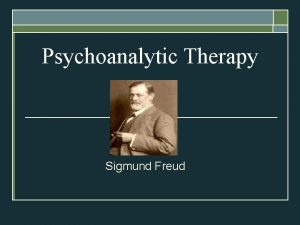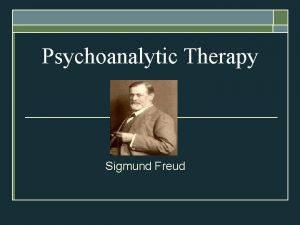Psychoanalytic Therapy Chapter 3 2010 Elsevier Inc Psychoanalytic






- Slides: 6

Psychoanalytic Therapy Chapter 3 © 2010 Elsevier, Inc.

Psychoanalytic/ Psychodynamic Theory Freud’s principle of psychic determinism included three mental structures: the id, the ego, and the superego. The crucial motivator in psychic interaction is anxiety, which is produced when an individual experiences conflict between the individual and the environment. Defense mechanisms, or adaptive responses to conflict, are short-term solutions to long-term problems. n Examples include: denial, repression, reaction formation, sublimation, projection, rationalization, regression, and displacement © 2010 Elsevier, Inc. 2

Psychoanalytic Therapy The goal of psychoanalysis is to “make conscious what is unconscious. ” Techniques include: free association, dream analysis, and transference. The therapist is the interpreter of the client’s behavior. Each of these models seeks to understand the influence of early childhood development on adult behavior. © 2010 Elsevier, Inc. 3

Psychoanalytic Approach to Crime The psychoanalyst must ask, “What are the conscious and unconscious desires in this person that are motivating his or her criminal behavior? ” Ego deficits such as ego strengths, ego failures, and the delinquent superego were used by Redl and Wineman (1951) to describe aggressive delinquents and why they turned to crime. © 2010 Elsevier, Inc. 4

Implications for Treatment The therapeutic environment and process should include these factors: n A hygienic environment n Focus on ego support n Exploitation of live events © 2010 Elsevier, Inc. 5

Psychoanalysis for Criminals Psychoanalysis is not practical for most criminals, although some aspects of it could be a part of a successful therapy program for offenders: n Recognizing defense mechanisms n Recognizing transference and countertransference n Addressing poor self-control and ego control n Recognizing the role of trauma and other major life events © 2010 Elsevier, Inc. 6











